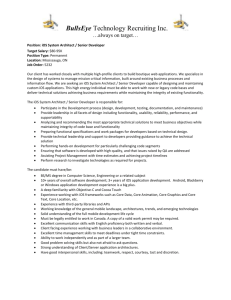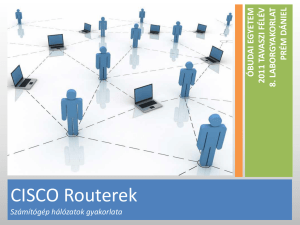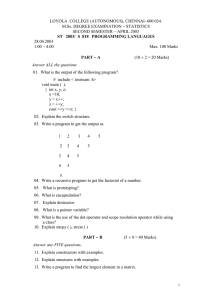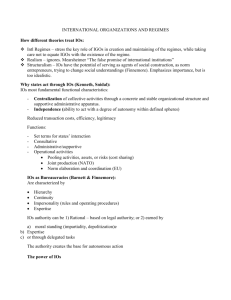Carlo Cafiero, Pietro Gennari and Steve Katz FAO Statistics Division 2014
advertisement
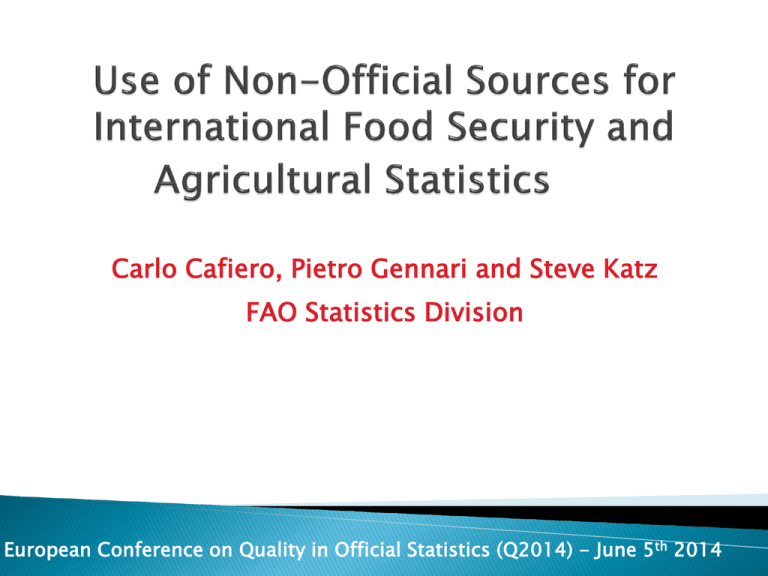
Carlo Cafiero, Pietro Gennari and Steve Katz FAO Statistics Division European Conference on Quality in Official Statistics (Q2014) - June 5th 2014 Background and Context Role of IOs as Producers of Official Stats Why and When to use Non-Official Sources FAO Examples “Voices of the Hungry” Project as Case-Study Reflections and Conclusions 2 Tension between NSOs and IOs due to data discrepancies and use of non-official sources (Human Dev. Report, MDG database, Big Data) Resulting in specific UNSC recommendations: ◦ 37th Session (2006) – IOs should avoid imputation unless specific country data are available & following consultations ◦ 42nd Session (2011) – On enhanced coordination of statistics within the UN system CCSA discussions on imputation practices and use of non-official sources ◦ 2006, 2009, 2010, 2011, 2012 ◦ 2013: adoption of “Recommended Practices on the Use of non-Official Sources in International Statistics” 3 Clear role of national governments for official statistics; Role of IOs more controversial Widespread view: limited to compiling existing governmental statistics SDMX guidelines: official statistics also apply to Intergovernmental Organizations Assumes Member States endorse statistical programmes of IOs, which is not always the case Added value: transformation of national data into international “Global Public Goods”, standardized and comparable across countries Requires: dedicated attention to quality and good governance 4 IOs normally use official sources In certain cases IOs cannot rely on official sources: ◦ Mandate and membership of IOs ◦ NSS data usually produced according to the highest professional standards ◦ National standards different from international standards ◦ Official sources in politically sensitive areas may be biased ◦ Missing data ◦ Confidentiality issues ◦ Difficulty of the NSS to keep up with the increasing demand for real-time data and new indicators But ONLY when all possibilities of using national data have been exhausted 5 Traditional use To ensure data harmonization and comparability across countries and regions To validate official data, to increase their accuracy and comprehensiveness To fill missing values/overcome confidentiality issues Non-traditional use To produce indicators not yet covered by official statistics (direct data collection) 6 Fertilizer Production, Trade and Consumption ◦ Main source is official statistics from countries, but additional data from the International Fertilizer Association (MoU) ◦ Specific problem: data confidentiality Early Warning and Emergency Preparedness Needs ◦ Real-time data not available from official sources ◦ Developing countries affected by emergencies lack the expertise needed ◦ Sources: News agencies, Extension services, Satellite images, Crowdsourcing Voices of the Hungry Project as a Case Study 7 Issue being Addressed Monitoring Food Insecurity is crucial to fight hunger Post 2015 Development Agenda requires creation of new indicators for global and national monitoring (food access) Global Monitoring cannot be based on national sources in the short-term Voices of the Hungry Project addresses this information gap 8 Methodology and Benefits ◦ ◦ ◦ ◦ ◦ ◦ Direct measure of people’s food insecurity in a timely and cost-effective way Short questionnaire as integral part of annual survey conducted by Gallup Inc. in 150 countries worldwide Based on nationally representative samples Can help in assessing emergency needs after famine or natural disasters Recommended as a key indicator for the monitoring framework of the Post 2015 Development Agenda Governments to adopt the indictor for targeted intervention, and monitoring/measuring impact of policies/programmes 9 Quality Assurance Mechanisms 1 ◦ ◦ ◦ ◦ Rigorous UN Procurement Rules adopted for the selection of data supplier Methodology Field-Tested: initially in 4 African countries Validation Studies: before adoption of a universal Scale of measurement Quality Stamp: FAO responsible for integrity and comparability of the different questionnaire language versions 10 Quality Assurance Mechanisms 2 ◦ ◦ ◦ Sustainability: Long-term contract with Gallup Inc.; World Bank and WHO have similar project arrangements External Review: All micro-data and methodology for its analysis will be publicly available Capacity Development: FAO to assist countries to include the Scale in future national household surveys; countries to eventually to take over data collection function 11 IOs add value to national data as provider of internationally comparable Global Public Goods IOs normally rely on national official data Use of non-official data only for very compelling reasons, including to fill information gaps or meet emerging needs Ultimate goal of providing higher quality and wider scope of global monitoring service Be combined with capacity development work for eventual national handover and sustainability 12 Use of non-official sources may create tension between IOs and NSOs Instruments needed to mitigate this tension: ◦ Full disclosure of methods/sources ◦ Adoption of quality assurance frameworks ◦ Stronger country involvement Particularly, strengthened statistics governance systems where Members endorse the statistical programmes of IOs and peer-review data FAO: new QAF adopted; Global Commission on Statistics to be established in 2015 13
